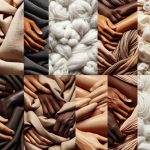When you’re dealing with hot, humid weather, choosing the right fabric can make all the difference in preventing chafing. You want breathable materials that keep you cool and comfortable, but not all fabrics perform the same. From natural fibers to innovative blends, each option has its benefits. Understanding these can help you make smarter choices for your wardrobe. So, what should you consider when selecting the best fabrics for your summer activities?
Table of Contents
Key Takeaways
- Cotton: Offers excellent air circulation and moisture absorption, reducing friction and keeping skin cool in humid conditions.
- Linen: Highly breathable and quick-drying, linen helps manage sweat and minimizes the risk of chafing.
- Rayon: Provides a soft feel and absorbs moisture rapidly, enhancing comfort and airflow in hot weather.
- Silk: Regulates body temperature and wicks moisture away, making it a comfortable option for sensitive skin.
- Blended Fabrics: Combine breathability and moisture-wicking abilities, offering stretch for improved movement and comfort in humid climates.
Understanding Chafing: Causes and Effects
Chafing occurs when skin rubs against skin or clothing, leading to irritation and discomfort. You might experience this in areas like your thighs, underarms, or the waistband.
Factors such as heat, humidity, and moisture can worsen the friction, making it more likely for you to feel that painful sting. When your skin gets irritated, it can become red, inflamed, and even develop blisters.
If you don’t address it, chafing can become a barrier to your activities, causing you to avoid exercise or outdoor fun.
The Role of Fabric in Chafing Prevention
When you’re active and on the move, the right fabric can make all the difference in preventing chafing. Fabrics that wick moisture away from your skin help keep you dry, reducing friction and irritation.
Look for lightweight, stretchy materials that allow for easy movement without clinging to your body. Synthetic blends, like polyester or nylon, are excellent choices since they dry quickly and offer breathability.
Avoid heavy or rough textures that can exacerbate chafing, especially in sensitive areas. Also, consider seamless designs that minimize contact points.
Cotton: Comfort and Breathability
When you’re looking for comfort and breathability, cotton should be at the top of your list.
Its natural fibers promote air circulation, helping you stay cool while managing moisture without feeling damp.
Plus, the variety of comfortable cotton weaves guarantees you can find the perfect fit for your needs.
Air Circulation Benefits
While you mightn’t think about it often, the fabric you choose can greatly impact your comfort during physical activity.
Cotton’s natural fibers allow for excellent air circulation, keeping you cool in hot, humid weather. This breathability helps prevent overheating, letting your body regulate its temperature more effectively.
When you’re moving, the last thing you want is to feel stifled by your clothing. Cotton’s loose weave promotes airflow, which can enhance your overall experience during workouts or outdoor activities.
You’ll appreciate how it feels against your skin, allowing sweat to evaporate without trapping moisture. By opting for cotton, you’re choosing a fabric that supports air circulation, helping you stay comfortable and focused on your performance.
Moderate Moisture Management
Choosing the right fabric not only enhances air circulation but also plays a significant role in moisture management.
Cotton is a popular choice due to its natural properties, providing comfort while helping to wick away sweat. Here are a few benefits of cotton in hot, humid conditions:
- Breathable: Allows air to flow, keeping you cool.
- Absorbent: Can soak up moisture, reducing skin irritation.
- Soft Texture: Feels comfortable against the skin, minimizing friction.
- Natural Fiber: Reduces the risk of allergic reactions, making it safe for sensitive skin.
While cotton mightn’t be the ultimate moisture-wicking fabric, its balance of comfort and breathability makes it a solid option for everyday wear in challenging weather.
Comfortable Cotton Weaves
Cotton weaves offer a delightful blend of comfort and breathability, making them ideal for those long, hot days. When you wear cotton, you’ll notice how soft it feels against your skin, reducing the chances of irritation. Its natural fibers allow air to circulate, keeping you cool and dry.
Plus, cotton absorbs moisture effectively, which helps manage sweat without feeling heavy.
For outdoor activities or casual outings, lightweight cotton options like poplin or lawn can be perfect. They provide a relaxed fit, allowing freedom of movement while minimizing chafing.
Just remember to choose tightly woven fabrics to guarantee durability without sacrificing comfort. With cotton, you’ll enjoy both style and practicality, making it a go-to choice for warm weather.
Linen: The Ultimate Moisture Management Fabric
When you’re looking for a fabric that excels in moisture management, linen stands out as an exceptional choice. Its natural properties make it perfect for hot, humid weather, helping you stay comfortable and chafe-free.
Here’s why you should consider linen:
- Breathability: Linen allows air to circulate, keeping you cool.
- Moisture-wicking: It absorbs sweat quickly, drawing it away from your skin.
- Quick-drying: Unlike other fabrics, linen dries fast, reducing the risk of chafing.
- Durability: Linen’s strength guarantees it withstands repeated wear, maintaining its quality.
With these benefits, linen not only enhances your comfort but also helps prevent chafing, making it a top choice for your warm-weather wardrobe.
Rayon: Softness and Quick-Drying Properties
When you choose rayon, you’re in for a soft and gentle feel against your skin.
Its rapid moisture absorption helps keep you dry, making it a great option for preventing chafing.
You’ll appreciate how comfortable and lightweight rayon can be, especially during warm weather.
Soft and Gentle Feel
Rayon stands out as an excellent choice for those seeking fabrics that prevent chafing, thanks to its softness and quick-drying properties.
You’ll appreciate how gentle it feels against your skin, making it perfect for those long, hot days.
Here are some key benefits of rayon:
- Luxurious Softness: Its smooth texture feels great, reducing friction.
- Breathability: Rayon allows air to circulate, helping you stay cool.
- Lightweight: The fabric’s lightness means you won’t feel weighed down.
- Versatile Styles: Rayon comes in various designs, so you can find something that fits your personal style.
Rapid Moisture Absorption
Not only does rayon offer a soft touch, but it also excels in rapid moisture absorption, making it an ideal choice for those prone to chafing.
When you wear rayon, it quickly pulls sweat away from your skin, keeping you dry and comfortable even in the hottest, most humid conditions. This quick-drying property helps reduce friction, which is vital for avoiding chafing during outdoor activities or workouts.
You’ll appreciate how lightweight and breathable rayon feels, allowing air to circulate and further enhancing your comfort. Plus, it’s easy to care for, so you can wash and wear it without hassle.
If you’re looking to stay chafe-free while enjoying your summer adventures, rayon should definitely be on your fabric list.
Polyamide (Nylon): Lightweight and Moisture-Wicking
Polyamide, commonly known as nylon, stands out as an excellent choice for preventing chafing during physical activities. Its lightweight and moisture-wicking properties make it ideal for hot, humid weather.
When you wear nylon, you’ll enjoy several benefits:
- Breathable material: Keeps your skin cool and comfortable.
- Quick-drying: Dries faster than cotton, reducing moisture buildup.
- Durable: Resists wear and tear, ensuring long-lasting wear.
- Smooth texture: Reduces friction against your skin, minimizing irritation.
With nylon garments, you can engage in your favorite activities without worrying about chafing.
This fabric is perfect for sports, workouts, or just a day out in the sun, allowing you to focus on what you love without discomfort.
Silk: Smooth Texture for Reduced Friction
If you’re looking for a fabric that feels luxurious against your skin while helping to prevent chafing, silk is an excellent option. Its smooth texture greatly reduces friction, making it a comfortable choice for hot, humid weather.
Unlike rough fabrics that can irritate your skin, silk glides effortlessly, allowing for easy movement. This lightweight material also breathes well, helping to regulate your body temperature and wick away moisture.
When you wear silk, you’ll feel cool and unrestricted, which is essential during those sweltering days. Plus, its natural properties make it hypoallergenic, ideal for sensitive skin.
Blending Fabrics for Enhanced Performance
While silk provides a luxurious option for preventing chafing, blending fabrics can take comfort and performance to the next level.
Combining different materials can enhance breathability, moisture-wicking capabilities, and durability, making them ideal for hot, humid conditions.
Here are some benefits of blended fabrics:
- Moisture-wicking: Keeps sweat away from your skin, reducing irritation.
- Breathability: Allows air circulation, helping to keep you cool.
- Stretchability: Enhances movement and comfort, preventing restrictive feelings.
- Durability: Strengthens the fabric, making it last longer through wear and washing.
Tips for Choosing the Right Fabric for Your Needs
When you’re choosing the right fabric to prevent chafing, consider factors like activity level, climate, and personal comfort. For high-intensity activities, opt for moisture-wicking materials that keep sweat away from your skin. Fabrics like polyester and nylon are great for this purpose.
Choosing moisture-wicking fabrics like polyester and nylon can help keep sweat away and prevent chafing during high-intensity activities.
If you’re in a hot, humid environment, lightweight and breathable options, such as mesh or bamboo, can help maintain airflow and reduce friction.
Pay attention to fit as well; looser clothing can minimize rubbing. Look for flat seams and tag-free designs to enhance comfort.
Finally, don’t forget to check for stretch; fabrics that move with you can reduce the chances of chafing considerably. Prioritize what feels best for you, and you’ll enjoy your activities more!
Frequently Asked Questions
How Do I Care for Delicate Silk Fabrics?
To care for delicate silk fabrics, you’ll want to hand wash them in cold water using a gentle detergent. Avoid wringing, instead, lay them flat to dry, keeping them away from direct sunlight to preserve their luster.
Can I Mix Different Fabric Types for Better Chafing Prevention?
You can mix different fabric types to enhance comfort and reduce chafing. Combining moisture-wicking materials with soft layers provides better protection, allowing you to stay cool and comfortable during hot, humid conditions without irritation.
What Clothing Styles Are Best for Hot, Humid Weather?
When dressing for hot, humid weather, opt for loose-fitting, breathable styles like tank tops, shorts, and lightweight dresses. These choices keep you cool and comfortable, allowing your skin to breathe and reducing sweat buildup.
How Often Should I Replace Moisture-Wicking Fabrics?
Think of your moisture-wicking fabrics like a trusty steed; they need care. Replace them every 6-12 months, or sooner if they lose their magic. Fresh gear keeps you comfortable and ready for any adventure ahead.
Are There Any Natural Alternatives to Synthetic Moisture-Wicking Fabrics?
Yes, there are natural alternatives! Fabrics like merino wool and bamboo can wick moisture effectively. They’re breathable and comfortable, so you’ll stay dry without relying solely on synthetic materials. Give them a try!
- Does Chiffon Fabric Stink - July 15, 2025
- Does Chiffon Fabric Affect the Economy - July 15, 2025
- Does Cotton Fabric Have a Nap - July 15, 2025







